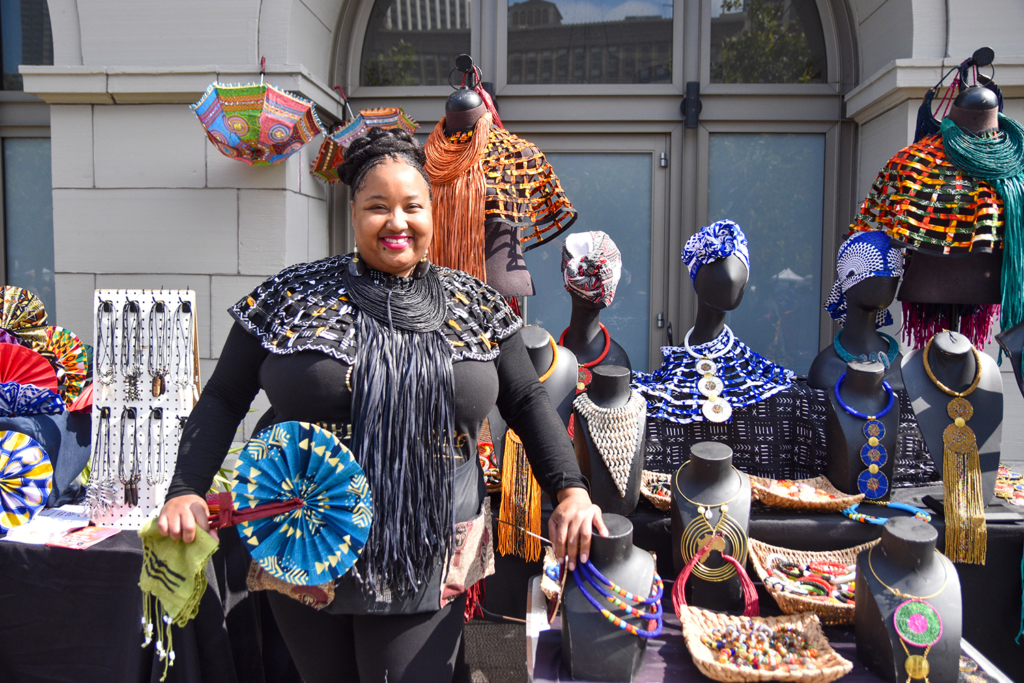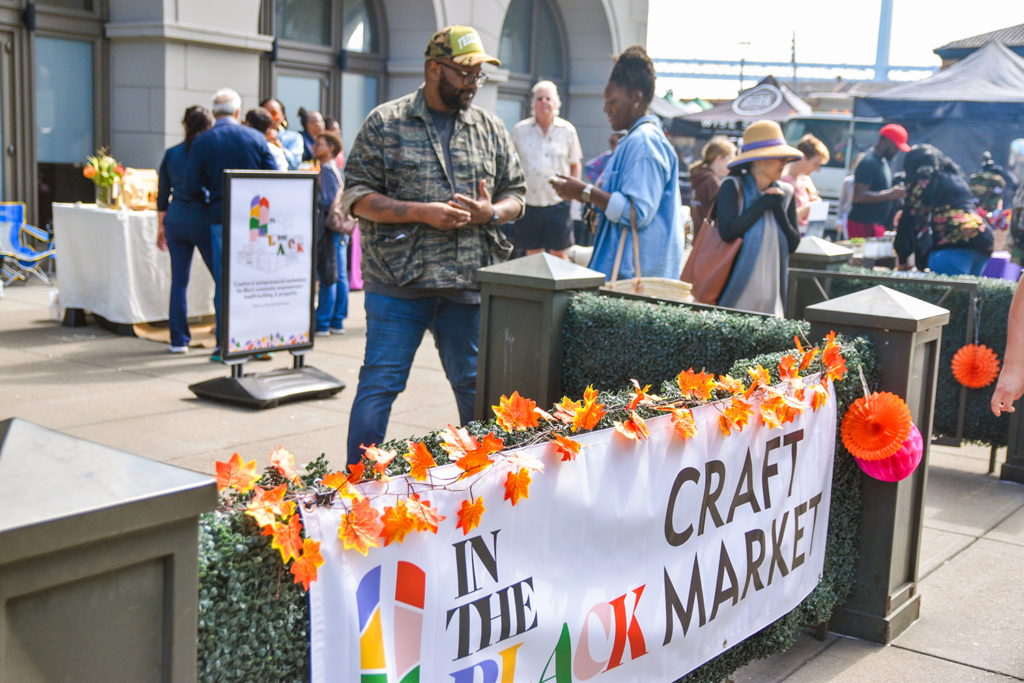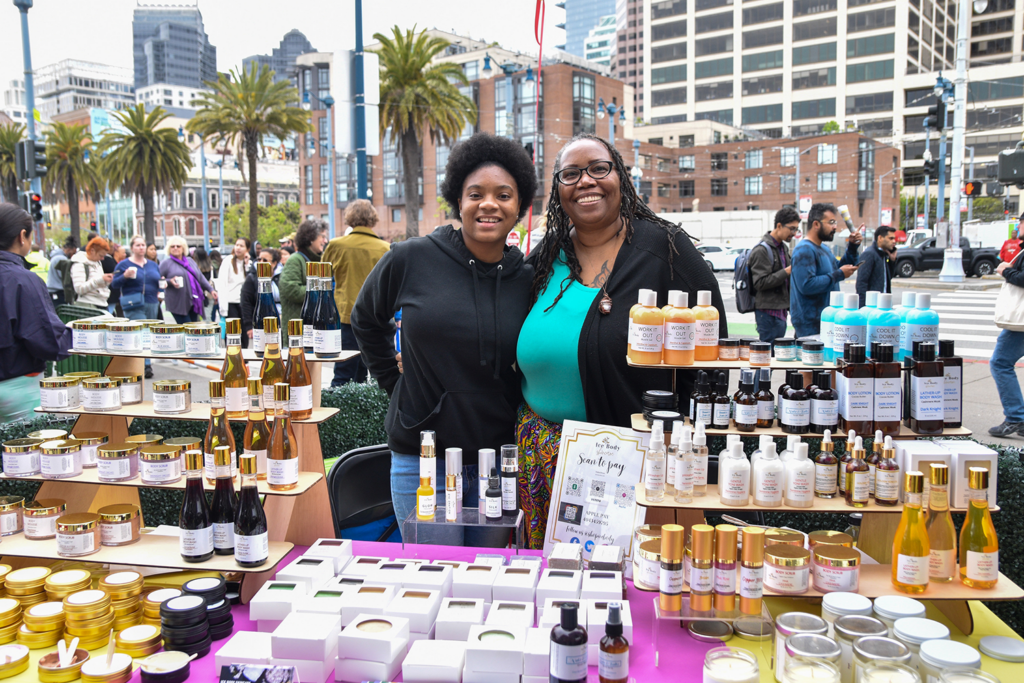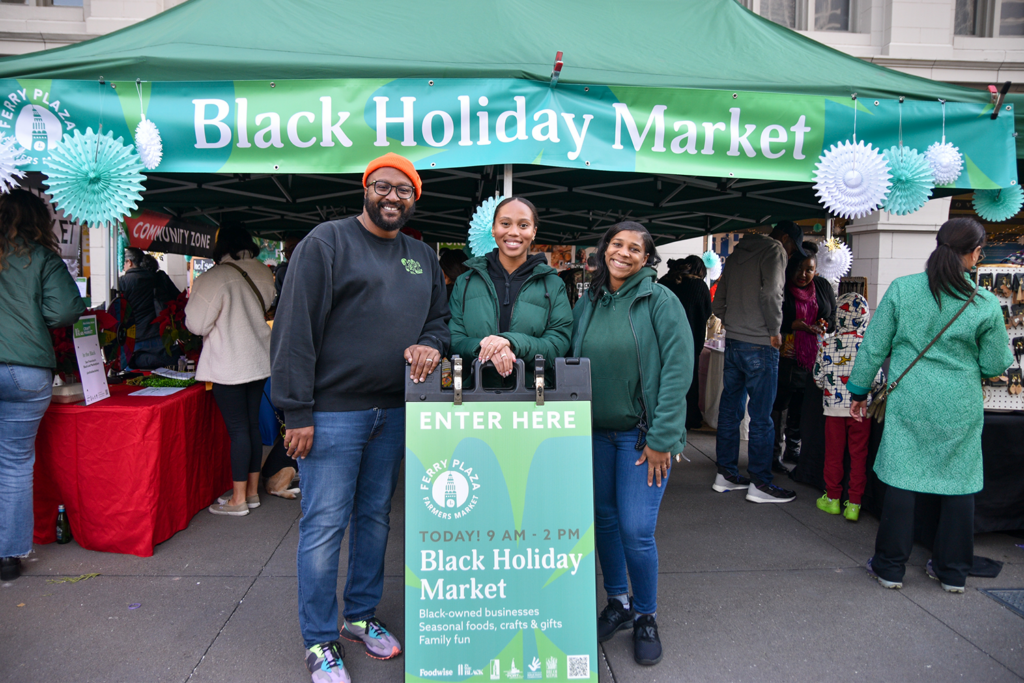In The Black and Black Businesses Reclaim Space in San Francisco’s Historic Fillmore District and Beyond
Selina Knowles, Communications Coordinator
February 16, 2024

“This is continuing a legacy,” says Nicole Williams, who founded Belle Noire, a retailer for vibrant traditional African accessories, in 2018. When the In The Black Marketplace opened in 2022, Nicole, a third-generation San Franciscan, seized the chance to grow her business in the city’s historic Fillmore District.
Located on the corner of Geary and Fillmore Street, In The Black provides an affordable retail space and technical business support for Black entrepreneurs, as part of an effort to reclaim the Fillmore District for, and build wealth within, Black communities. As of last year, Foodwise and In The Black have officially partnered to offer opportunities for Black entrepreneurs beyond the Fillmore at Pop-Ups on the Plaza events at the Ferry Plaza Farmers Market, bringing Black designers and entrepreneurs to the waterfront.

The Harlem of the West
“For the longest time, people have referred to the Fillmore as being the ‘Harlem of the West,’” says Joshua Farr, In The Black’s Marketplace Manager. The Fillmore District in San Francisco has a long history as a refuge for immigrants and African Americans, who were often unwelcome in other neighborhoods.
Following the surge of migration to San Francisco during the Gold Rush, the city expanded to what’s known as the Western Addition in the 1860s. In the decades after the 1906 earthquake, the Western Addition developed and attracted Japanese and other immigrants, who could not afford to live in other San Francisco neighborhoods, as well as African Americans, who were systemically denied housing ownership and even rentals in most parts of the city.
Coinciding with the bombing of Pearl Harbor, the United States entering World War II, and the forced internment of Japanese Americans, Black Americans started migrating from the South to work in Bay Area shipyards, and their numbers in the Fillmore grew significantly.
“What ended up happening was, as Japanese Americans were forcibly moved into the internment camps, the Black community found themselves as stewards of the spaces that were left behind,” says Joshua. “And so for quite a while, the Fillmore community created a renaissance for Black families in terms of being able to become business and property owners and build strong roots in the community.”

Reclaiming a Changed Fillmore After Urban Renewal
“As time passed, there was a re-urbanization of the Fillmore, and a lot of Black families and businesses found themselves being priced out and being kicked out,” says Joshua. In 1949, the Western Addition joined a lineup of American neighborhoods as a target for major urban renewal, in a plan that would affect nearly 20,000 residents.
Among the impacts of San Francisco Redevelopment Agency’s Western Addition Project A-1, two-lane Geary Street was widened into four-lane Geary Boulevard, which became an unwritten financial dividing line, and plans were drawn to displace 4,000 residents to create the Japanese Culture and Trade Center.
In 1990, 11 percent of San Francisco residents were Black, and now, in 2024, only 6 percent of city residents are Black. Many displaced Black families and individuals moved to different areas like Bayview-Hunters Point and Oakland and the East Bay.
In 2022, the San Francisco Housing Development Corporation opened the In The Black Marketplace, with support from the Dream Keeper Initiative. The marketplace serves their mission to foster financial opportunity and stability through the economic empowerment and revitalization of the Fillmore.
Joshua continues, “One of the most important things for In The Black is to change that narrative of displacement and remind the community of the beauty of having diverse businesses.”

Creating Pathways for Black Businesses to Thrive
The financial cost and risk of opening a business in the city can be prohibitive for early-stage or small businesses entrepreneurs, especially Black Americans. In The Black focuses on lowering these barriers by offering affordable rent for retail space and facilitating an online marketplace. This win-win setup serves both the Black-owned businesses and the residents of the Fillmore District, who get to experience a diversity of offerings.
“I take a lot of pride in being connected to the In The Black store,” says Nicole. After regularly receiving offers for the jewelry pieces she would wear in her daily life, Nicole started Belle Noire (French for “Beautiful Black”) to connect women makers in Africa and the African Diaspora with a local market. A few years into growing her business, she says she still benefits from the business education, funding, and retail space that In The Black provides.
Vickie Brown, another vendor at In The Black Marketplace, also appreciates the practical training and the physical and online retail spaces. Vickie started Ice Body Shop, which sells handmade, plant-based skincare products, with her daughter, Deja, in 2015. After Ice Body Shop was selected to be in the opening lineup of the store, Vickie took one of In The Black’s business courses, and she just started another course in financial wellness.
“My business has flourished even more. I get connected with a lot of different events,” she says, adding that she enjoys meeting customers face-to-face. Vickie and Nicole have both popped up at Foodwise’s Pop-Ups on the Plaza events, which is where Foodwise and In The Black’s partnership started.

Bringing Diversity to the Waterfront and Reaching New Audiences at the Farmers Market
Foodwise connected with In The Black leading up to the third annual Juneteenth on the Waterfront event in 2023. One of the quarterly Pop-Ups on the Plaza events (supported with funding from the Port of San Francisco and the San Francischo Human Rights Commission), this celebration grew with the addition of a craft market featuring In The Black affiliated Bay Area Black designers. In The Black is now an official community partner in Foodwise’s Building Equity Program.
“The partnership has given us the opportunity to highlight our businesses to a neighborhood that may not necessarily make it down to the Fillmore,” says Joshua about the Pop-Ups on the Plaza events.
“Market pop-ups have a tremendous positive impact on my business because I’m exposed to customers that I wouldn’t necessarily be exposed to,” Nicole agrees. “Also, when people come to visit San Francisco, one of the first questions they ask is, ‘Where are all the Black people?’ And I love that Foodwise is very deliberate in saying, ‘Yes, we’re still here.’”
Foodwise’s Operations Coordinator Deven Okry, who organizes the pop-up events, shares, “The hope behind this partnership was to expand the variety of vendors and connect with another community partner. Working with In The Black vendors complements the farmers market by creating a space for non-food vendors and increases the amount of Black vendors we can support.”
Since co-hosting the In The Black craft market at Juneteenth on the Waterfront in June and the Black Holiday Market in December, Foodwise has received requests from both vendors and shoppers for more events. This year, Foodwise and In The Black will host two additional Black Creators Craft Markets at the Ferry Plaza Farmers Market, the first on February 17 and the second on August 17.
“Foodwise pop-ups are a reflection to me of the best part of San Francisco, which is diversity, great products, and great people,” says Nicole.
Support In The Black and local Black-owned businesses at Pop-Ups on the Plaza: Black Creators Craft Market on tomorrow, February 17 (9 am – 2 pm), at the Ferry Plaza Farmers Market. Save the date for future Pop-Ups on the Plaza events.
Visit In The Black Marketplace at 1567 Fillmore Street, and connect with them on Instagram.
Follow Belle Noire and Ice Body Shop on Instagram, and reach out to Nicole to learn more about her ongoing book drive for children in Ghana.
Topics: Building Equity program, Equity, Events, Farmers market, Local, Partners, Small business
